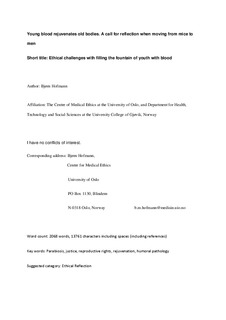| dc.description.abstract | Connecting the circulatory system of old and young mice (parabiosis) is documented to have rejuvenating effects on cells, tissues, organs, and functions. A wide range of benefits are envisioned. Blood-based rejuvenation can come to totally change population health and aging. The first blood rejuvenation studies on humans with Alzheimer's disease have started. It puts blood at the center of therapy and revitalizes the historical line of humoral pathology from Hippocrates and Harvey, creating a new type of ‘bloodletting.' However, moving from mice to men requires careful consideration. Parabiosis actualizes well-known ethical challenges, such as just distribution of health care, avoiding disparities, and providing equal access to health care resources, as well as issues of human enhancement. However, it also poses new problems. Using internal substances in some persons as means to rejuvenate others calls for ethical reflection. New type of ‘blood bonds' may result from the continuous demand for specific types of blood. Even if rejuvenating substances from blood may be artificially and cheaply produced and justly distributed, problems arise: survival may have to be balanced against reproduction, as reproductive age increases. Eternal youth and endless bliss have always been vital human dreams. Although parabiosis may bring us closer to the fountain of youth than ever, it is still too early to provide full-fledged assessments of its implications or to foresee how it will change health, aging, medicine, and society. However, in order to bring our reflective abilities on par with our technical skills, we need to start reflection now. | nb_NO |
